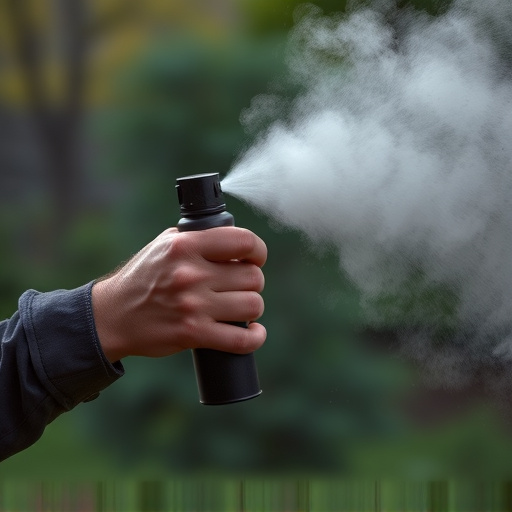Pepper spray's effectiveness relies on tactical communication and understanding its mechanics. Strategic spraying techniques, combined with clear verbal warnings, reduce physical intervention needs. Environmental factors like wind and terrain impact spray dispersion, requiring coordinated deployment from multiple angles. Legal considerations and proper post-deployment care are crucial for maintaining defensibility and enhancing deterrence strategies. Effective radio communications improve team coordination, ensuring swift responses during deployment.
In today’s world, understanding self-defense mechanisms is paramount. Pepper spray, a powerful deterrent, offers individuals an effective line of defense against potential threats. This comprehensive guide explores the multi-faceted approach to using pepper spray as a safety measure. We delve into the science behind its chemical composition, the art of tactical communication during deployment, and legal considerations that ensure responsible use. Additionally, we highlight post-deployment care and training, emphasizing continuous improvement for optimal self-defense strategies.
- Understanding Pepper Spray: Chemical Composition & Effects
- Tactical Communication: Verbal Warnings Before Deployment
- Effective Delivery Techniques for Optimal Protection
- Legal Considerations: Use of Force & Self-Defense Rights
- Post-Deployment Care & Training for Continuous Improvement
Understanding Pepper Spray: Chemical Composition & Effects
Pepper spray, a powerful deterrent and defense mechanism, is a chemical agent designed to incapacitate an aggressor temporarily. Its primary active ingredient is capsaicin, the same compound that gives spicy foods their heat. This irritant affects the eyes, nose, throat, and lungs, causing temporary blindness, tears, coughing, and difficulty breathing. The spray creates a layer of oleoresin capsicum (OC) on the skin, which triggers a painful sensory response.
When deployed during tactical situations, understanding the chemical composition is crucial for effective tactical communication. Law enforcement officers and individuals trained in self-defense must be aware of the spray’s range, wind conditions that can affect its direction, and the need to maintain distance until the effects subside. Effective communication during spray deployment ensures everyone involved is alert, cautious, and coordinates their actions to minimize risks and maximize safety.
Tactical Communication: Verbal Warnings Before Deployment
In the heat of a confrontational situation, tactical communication plays a vital role in managing potential threats before and during pepper spray deployment. Before resorting to spraying, law enforcement officers are trained to issue clear and firm verbal warnings to de-escalate the scene. These warnings serve as a crucial defense mechanism, providing individuals with a final chance to back down and avoid the use of force.
Effective tactical communication involves using assertive yet calm language to convey the intent to deploy pepper spray if the subject continues to pose a threat. Officers must clearly articulate the consequences, ensuring the individual understands the imminent use of this deterrent. This step is essential in minimizing the need for physical intervention and can often prevent escalating conflicts, making it a fundamental aspect of public safety protocols.
Effective Delivery Techniques for Optimal Protection
Effective delivery techniques are paramount in maximizing the protection offered by pepper spray. For optimal results, users must employ strategic spraying patterns and angles. The key lies in tactical communication during spray deployment—coordinating with allies to create a comprehensive defense zone. By maintaining clear lines of communication, individuals can ensure that the spray reaches potential attackers from multiple directions, significantly increasing its deterrence factor.
Additionally, understanding wind patterns and terrain features is crucial. Spraying upwards or into the wind can help prevent the fog from blowing away, ensuring it lingers and affects the intended targets. Knowing when and how to deploy pepper spray strategically, combined with effective tactical communication, enhances personal safety and serves as a powerful defensive mechanism in various situations.
Legal Considerations: Use of Force & Self-Defense Rights
When using pepper spray as a deterrent or defense mechanism, understanding legal considerations surrounding the use of force and self-defense rights is paramount. Each jurisdiction has specific laws dictating when and how pepper spray can be employed legally. For instance, in many places, individuals have the right to protect themselves and their property, but the application of force must be proportional to the perceived threat.
Tactical communication during spray deployment plays a crucial role in ensuring legal defensibility. Law enforcement agencies often emphasize the importance of verbal de-escalation attempts before resorting to pepper spray. Clearly communicating intentions and warning individuals to back off can be documented as reasonable efforts to avoid excessive force, reinforcing self-defense rights.
Post-Deployment Care & Training for Continuous Improvement
After deploying pepper spray, post-deployment care and training are crucial for continuous improvement in deterrence strategies. The immediate aftermath involves ensuring proper decontamination procedures to mitigate any residual effects on both officers and suspects. This includes having designated areas or debriefing spaces equipped with eye wash stations and protective gear to attend to those affected by the spray.
Additionally, tactical communication during spray deployment is essential. Training sessions should emphasize clear and concise radio communications to relay information about the situation, the type of pepper spray used, and its expected duration. This real-time exchange facilitates better coordination among team members, allowing for swift response adjustments and enhancing overall operational effectiveness.
Pepper spray, as a powerful personal defense mechanism, is only effective if used tactically and responsibly. By understanding its chemical composition, delivering it effectively, and communicating verbally before deployment, individuals can ensure optimal protection while navigating legal considerations. Continuous improvement through post-deployment care and training underscores the importance of mastering this deterrent, making it a valuable tool in today’s safety landscape. Remember that tactical communication during spray deployment is key to responsible self-defense practices.
